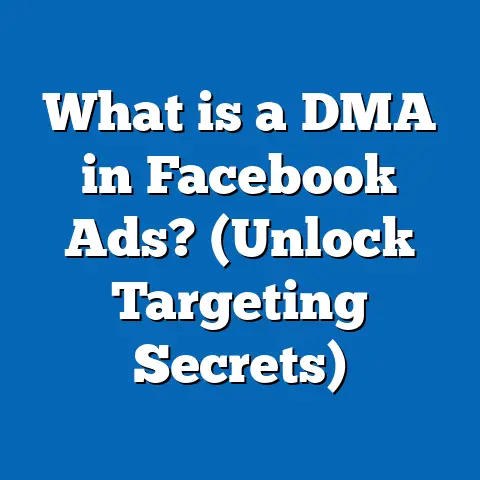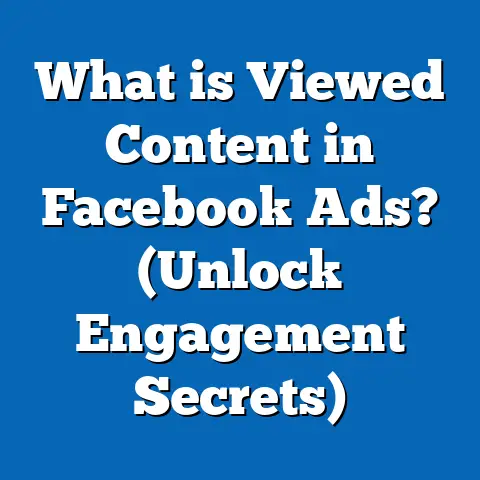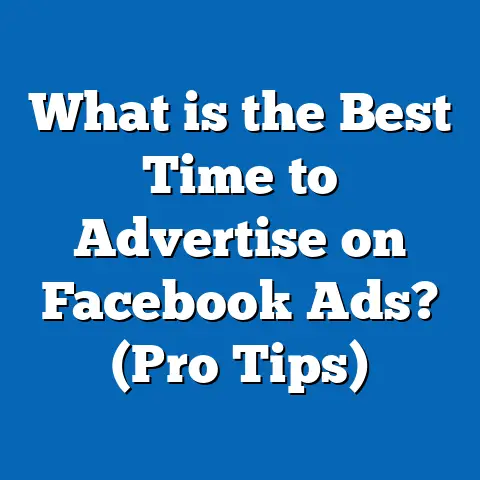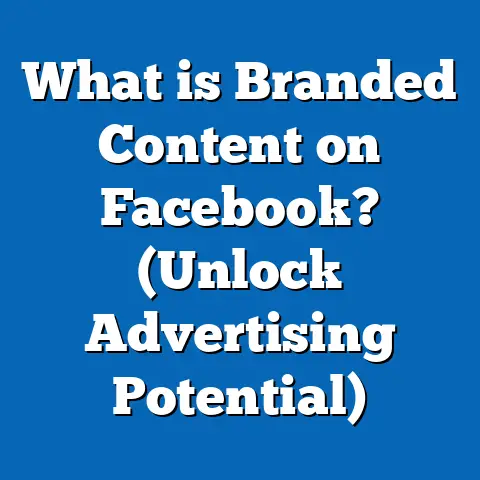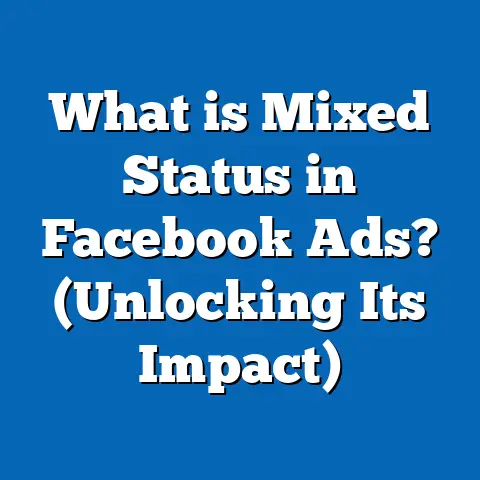What is the Most Profitable Product for Facebook Ads? (Revealed)
Introduction: The Power of Uniqueness in Facebook Advertising
In the ever-evolving digital marketplace, where every business vies for consumer attention, uniqueness becomes the most valuable currency. Facebook ads offer incredible opportunities with their vast user base and advanced targeting tools, but simply launching ads isn’t enough. To truly succeed and generate profit, marketers must identify the right product—one that stands out, resonates deeply with a specific audience, and leverages Facebook’s ad ecosystem effectively.
What makes a product profitable on Facebook? How do you choose a product that not only attracts clicks but converts those clicks into sales at a sustainable profit? This guide reveals everything you need to know about identifying and marketing the most profitable products for Facebook ads in 2025. Backed by research, real-world data, and actionable strategies, this comprehensive resource is designed to help marketing professionals and business owners alike master Facebook advertising profitably.
Understanding Profitability in Facebook Ads
What Does “Profitable Product” Mean in the Context of Facebook Ads?
Profitability is more than just selling a lot of items; it’s about balancing costs and revenues efficiently. For Facebook advertising, profitability hinges on four core factors:
- Ad Spend Efficiency: How much does it cost to acquire a customer?
- Product Margins: What portion of each sale is profit after costs?
- Conversion Rates: How many people who see your ads complete a purchase?
- Customer Retention: Will customers buy again or refer others?
A product that sells well but has thin margins or requires high ad spend may not be profitable. Conversely, a product with high margins and a targeted audience can deliver excellent returns even with moderate sales volume.
Key Metrics to Track for Profitability
To evaluate if a product is profitable when advertised on Facebook, you need to monitor these metrics carefully:
- Return on Ad Spend (ROAS): Measures revenue generated for every dollar spent on ads. A ROAS of 3:1 or higher is generally considered good.
- Cost Per Acquisition (CPA): Average cost to convert one customer. This should be lower than the profit margin per sale.
- Click-Through Rate (CTR): Percentage of people who click your ad after seeing it. While not directly tied to profitability, a higher CTR usually leads to better conversion opportunities.
- Conversion Rate: Percentage of clicks that result in sales. Higher conversion means better ad targeting and product-market fit.
- Customer Lifetime Value (CLV): Total revenue expected from a customer over their relationship with your brand. Products with subscription or repeat purchase potential increase CLV.
Why Product Uniqueness Matters on Facebook
Facebook’s algorithm favors ads that engage users meaningfully. Unique products create engagement because they:
- Spark curiosity or emotional responses.
- Fulfill unmet needs.
- Stand out against competitors.
- Generate word-of-mouth and shares.
Marketers who focus on unique products reduce ad fatigue and increase relevance scores, which lowers advertising costs and improves profitability.
The Most Profitable Product Categories for Facebook Ads in 2025
Let’s explore the top product categories that currently show strong profitability on Facebook, supported by data and examples.
1. Health & Wellness Products
The health & wellness sector consistently outperforms many others due to growing consumer interest in personal well-being.
Market Data
- The global health supplement market was valued at $140 billion in 2023 and is projected to grow annually at 8.6% through 2030 (Grand View Research).
- Facebook ad data shows wellness brands achieving an average ROAS of 4:1 or higher.
Why It’s Profitable
- Consumers often seek trusted solutions for their health concerns.
- Supplements and fitness gear can be marketed with educational content.
- Many products support subscription models for recurring revenue.
Case Study: NutraGlow Vitamins
NutraGlow, a vitamin supplement brand, targeted health-conscious women aged 25-45 with video ads explaining the science behind their product. Using split tests between testimonials and educational content, they found testimonial videos had a 35% higher conversion rate. Within six months, NutraGlow achieved a consistent ROAS of 6:1 while growing their subscriber base by 25%.
2. Beauty and Skincare Products
Beauty remains one of the highest growth categories online, driven by social media trends and influencer culture.
Market Insights
- The skincare market reached $145 billion globally in 2022 and is expected to hit $189 billion by 2027 (Statista).
- Influencer-driven ads on Facebook see up to 50% higher engagement than standard formats.
Why It Works
- Visible before-and-after results make compelling ad creatives.
- High repeat purchase rates increase lifetime value.
- Customers trust peer reviews and influencer endorsements.
Example: GlowPure Skincare
GlowPure, a Korean skincare line, leveraged carousel ads showcasing step-by-step skincare routines combined with authentic user testimonials. They targeted women aged 20-40 with interests in beauty trends and skincare influencers. Their campaign resulted in 40,000 new customers within six months and lowered CPA by 15% through retargeting.
3. Tech Gadgets and Accessories
Tech enthusiasts seek innovative gadgets that solve everyday problems or enhance lifestyles.
Industry Data
- Consumer electronics e-commerce sales grew by 25% in 2024 (eMarketer).
- Video ads featuring product demos increased click-through rates by over 30% compared to static images (Facebook Marketing Science).
Why It’s Profitable
- High perceived value justifies higher ad spend.
- New gadgets often have unique features easy to highlight.
- Early adopters respond well to targeted ads emphasizing innovation.
Case Study: SoundWave Wireless Earbuds
SoundWave launched wireless earbuds with noise-cancellation technology. Their campaign used influencer reviews combined with short demo videos showing key features. They targeted tech-savvy males aged 18-35 interested in music and gaming. The campaign achieved ROAS of 5.5:1 and reduced CPA by 20% after optimizing lookalike audiences.
4. Home Improvement & Decor
Post-pandemic shifts have made home improvement a booming category.
Market Trends
- Facebook searches for home decor increased by more than 50% over two years.
- Dynamic ads for furniture increased purchases by 35% compared to standard ads (Facebook Business).
Why It Sells Well
- Consumers invest in comfort and aesthetics.
- Premium pricing allows for good margins.
- Visual nature of products works well with Facebook’s ad formats.
Example: ArtisanWood Furniture
ArtisanWood used dynamic product ads targeting homeowners aged 30-50 who had previously browsed home decor sites. They combined lifestyle images with customer reviews emphasizing craftsmanship. Results showed CPA 20% below average industry rates, with a ROAS of 4.8:1 within three months.
5. Fashion & Apparel (Niche Segments)
While fashion is competitive, niche apparel such as sustainable or custom-made items perform strongly.
Data Highlights
- Sustainable fashion sales are projected to reach $9.81 billion globally by 2025.
- Ads targeting eco-conscious consumers have seen engagement rates up to 45% higher (Facebook Analytics).
Why Niche Fashion Works
- Emotional connection with values like sustainability.
- Frequent new collections keep audience attention.
- Customization options increase perceived value.
Case Study: EcoStride Activewear
EcoStride sells eco-friendly activewear targeting millennials interested in sustainability and fitness. They ran campaigns using lookalike audiences from past purchasers combined with video testimonials from customers highlighting sustainability efforts. This led to a fivefold increase in conversion rates within six months.
- Google Trends: Identify rising product interest over time.
- Facebook Audience Insights: Understand demographics and interests related to your products.
- Industry Reports: Use market data from sources like Statista or Nielsen.
Look for products with growing demand but less saturation on Facebook.
Step 2: Validate Uniqueness and Differentiation
Ask yourself:
- Does this product solve an urgent problem?
- How does it differ from existing alternatives?
- Can I create compelling stories or visuals around it?
Uniqueness can be based on features, price point, brand story, or customer experience.
Step 3: Calculate Profit Margins and Advertising Limits
Understanding your financial limits is critical: Break-even CPA=Product Price×Profit Margin Percentage\text{Break-even CPA} = \text{Product Price} \times \text{Profit Margin Percentage}
Example:
- Product price = $80
- Profit margin = 40%
Break-even CPA = $80 × 0.40 = $32
This means you must acquire customers for less than $32 through ads to be profitable.
Step 4: Develop Buyer Personas & Targeting Strategy
Create detailed profiles including:
- Age, gender, location
- Interests & behaviors
- Pain points & motivations
- Buying habits
Use these personas to set up precise Facebook targeting campaigns.
Step 5: Run Small Budget Tests & Analyze Data
Launch multiple ad sets focusing on different audiences and creatives:
- Use A/B testing for images vs videos
- Test different headlines and calls-to-action
- Monitor ROAS, CPA, CTR daily
Scale up budget on winning combinations gradually.
In-depth Case Studies of Profitable Facebook Ad Campaigns
Case Study #1: FitFlex Fitness Apparel Brand
Background: A startup selling performance-enhancing workout clothes aimed at millennials aged 18–35.
Strategy: Produced short videos featuring athletes wearing FitFlex apparel during workouts, highlighting breathability and style benefits. Ads targeted interests such as fitness influencers and gym memberships.
Results:
- Initial ROAS: 4:1
- After optimizing for lookalike audiences based on highest spenders, ROAS improved to 7:1.
- CPA dropped by 30% after switching from photo ads to video testimonials.
Key Insight: Authentic visuals that demonstrate product benefits drive higher engagement and conversions.
Case Study #2: PureGlow Organic Skincare Line
Background: Small business specializing in chemical-free skincare products.
Strategy: Partnered with micro-influencers to create genuine review videos; ran carousel ads showing step-by-step skincare routines using their products; utilized retargeting for website visitors who viewed product pages but didn’t purchase.
Results:
- Subscription rate increased by 20% within three months.
- CPA decreased by 35%, thanks to effective retargeting.
- Overall ROAS averaged around 5:1 consistently.
Key Insight: Combining influencer credibility with retargeting funnels maximizes conversions and reduces ad waste.
Case Study #3: TechTrend Wireless Gadgets
Background: Company launched a new wireless charging station targeted at tech-savvy professionals.
Strategy: Used demo videos highlighting ease-of-use; targeted interests like “smart home” and “tech innovations” on Facebook; implemented dynamic retargeting based on user activity on their website.
Results:
- Achieved initial ROAS of 3.5:1.
- After introducing lookalike audiences based on highest lifetime value customers, ROAS improved to over 6:1.
- Engagement rates increased by over 40% after adding short educational videos explaining product features.
Key Insight: Educational content paired with precise audience targeting helps convert skeptical buyers into advocates.
Comparing Facebook Ads With Other Digital Advertising Platforms
| Platform | Strengths | Weaknesses | Best Suited For |
|---|---|---|---|
| Granular demographic & behavior targeting; large audience size; versatile ad formats | Rising CPC costs; organic reach decline | B2C products; retargeting campaigns | |
| Highly visual; younger demographic; strong influencer integration | High competition in popular niches | Fashion, beauty, lifestyle brands | |
| Google Ads | Intent-based search targeting; high purchase intent | Higher CPCs; less branding potential | Direct response sales; services |
| TikTok Ads | Viral potential; low-cost video ads; younger audience | Less mature platform; limited targeting options | Trendy products; youth-focused brands |
Facebook’s combination of interest-based targeting plus behavioral data offers unique advantages for niche products needing detailed segmentation.
Advanced Strategies To Boost Product Profitability On Facebook Ads
Utilize Dynamic Product Ads (DPA)
DPAs automatically show users relevant products based on their browsing history or interaction with your website/app.
Benefits:
- Personalized experience increases conversion likelihood.
- Reduces cart abandonment rates.
Example: An online shoe store saw a 25% increase in sales after implementing DPAs targeting users who viewed specific shoe models but didn’t purchase immediately.
Leverage Lookalike Audiences Effectively
Create lookalike audiences from your highest-value customers or website converters:
- Helps expand reach while maintaining relevance.
- Often reduces CPA compared to cold audiences.
Example: A cosmetics brand improved ROAS by 40% using lookalikes derived from customers who purchased subscriptions rather than single items.
Continuous Creative Testing & Optimization
Regularly test:
- Ad formats (video vs static images)
- Messaging styles (emotional vs logical)
- Call-to-actions (Shop Now vs Learn More)
Use Facebook’s built-in split testing tools to make data-driven decisions rather than guessing what works best.
Practical Tips For Selecting Products For Facebook Advertising Success
- Focus on Emotional Appeal: Products tied to lifestyle improvements or status often convert better.
- Select Items With Solid Margins: Aim for at least a 30–50% profit margin after all costs.
- Choose Products With Repeat Purchase Potential: Subscriptions or consumables boost lifetime value.
- Avoid Commodities: Generic products without differentiators are hard to market profitably.
- Craft Compelling Stories: Use narratives that resonate emotionally through your ads.
- Optimize Your Checkout Experience: Mobile-friendly pages with quick load times reduce drop-offs.
- Use Social Proof: Incorporate reviews, testimonials, or influencer endorsements in your creatives.
- Stay Updated With Platform Changes: New ad formats or targeting options can provide competitive advantages quickly.
Emerging Trends Impacting Product Profitability on Facebook Ads
AI-Powered Ad Personalization
Facebook increasingly uses machine learning algorithms to personalize ads dynamically based on user behavior patterns—marketers can leverage this by providing varied creatives for different audience segments.
Increased Focus on Privacy & Data Restrictions
With privacy regulations tightening (e.g., iOS updates), advertisers must adapt by focusing more on first-party data collection through lead magnets or email capture linked with Facebook campaigns.
Video Content Dominance
Video continues to outperform static images in engagement and conversion metrics—investing in quality video production tailored for mobile viewing is essential.
Integration With E-commerce Tools
Facebook Shops and Instagram Shopping integrations allow seamless buying journeys without leaving the platform—these features increase conversion rates for physical products significantly.
Summary & Next Steps To Maximize Profitability With Facebook Ads
Key Takeaways:
- Profitability depends on selecting products that combine uniqueness with strong demand.
- Health & wellness, beauty/skincare, tech gadgets, home decor, and niche fashion lead current trends.
- Deep audience understanding, clear financial calculations, and continuous testing are non-negotiable.
- Advanced tactics like dynamic product ads and lookalike audiences scale profitability efficiently.
Action Plan:
- Conduct detailed market research using tools like Google Trends and Facebook Audience Insights.
- Validate your product’s uniqueness through competitor analysis and customer feedback.
- Calculate your break-even CPA based on margins before investing heavily in ads.
- Develop precise buyer personas and target accordingly using Facebook’s detailed options.
- Launch small-scale tests with various creatives; track ROAS and CPA closely.
- Scale winning campaigns gradually while optimizing ad creatives continuously.
- Leverage advanced features like dynamic product ads and lookalike audiences for sustained growth.
- Keep abreast of industry trends such as privacy changes and new ad formats for timely adaptation.
By following these steps grounded in data-backed insights, marketers can confidently select the most profitable products for Facebook advertising campaigns that drive real business growth in 2025 and beyond.

